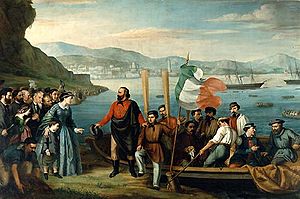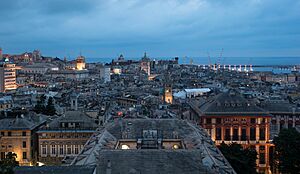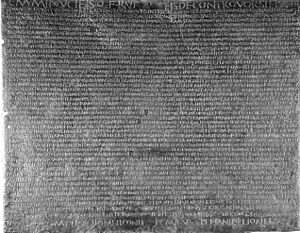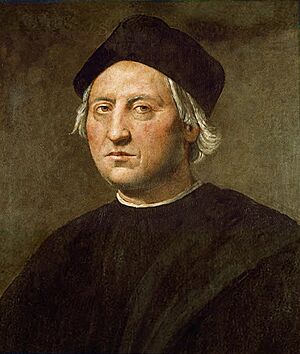History of Genoa facts for kids
Genoa, Italy, has always been a very important port city on the Mediterranean Sea.
Contents
Ancient Genoa: Early Settlers and Roman Times
The area around Genoa has been lived in for a very long time, since about 5,000 to 4,000 years before Christ. Ancient people called the Ligures lived here; the region of Liguria is named after them. Archaeologists found objects showing that the Ligures in Genoa traded with the Etruscans and the Greeks. Around 500 BC, the first town, called an oppidum, was built on a hill known today as Castello. This hill is now part of Genoa's old city.
The ancient Ligurian city was also known as Stalia. It made an alliance with Rome during the Second Punic War (218-201 BC). Because of this alliance, the Carthaginians destroyed Stalia in 209 BC. But the town was rebuilt! After the Carthaginian Wars ended in 146 BC, Genoa gained rights as a Roman town. The original fort grew, and people traded things like animal skins, wood, and honey. Goods were moved from Genoa to big cities inland like Tortona and Piacenza. Roman ruins, including an amphitheater, have been found here.
The name "Genoa" might come from the Latin word genu, meaning "knee." Or it could be linked to the Roman god Janus, who had two faces, because Genoa looks both towards the sea and the mountains. Another idea is that it comes from ianua, meaning "door" or "passage." This might refer to its location in the middle of the Ligurian coast. The Romans called it oppidum Genua.
Genoa After the Roman Empire
After the Western Roman Empire fell, the Ostrogoths took over Genoa. Later, the Byzantines controlled it. In 568, the Lombards invaded Italy, and the Bishop of Milan moved to Genoa for safety. Around 643, the Lombards finally captured Genoa.
In 773, the Lombard Kingdom became part of the Frankish Empire. The first Frankish leader of Genoa was Ademarus. During this time, the Roman walls that the Lombards had destroyed were rebuilt and made bigger. For the next few centuries, Genoa was a small town. But it slowly built up its merchant fleet, which would become very important for trade in the Mediterranean Sea.
In 934–935, a fleet from the Fatimid Caliphate attacked and burned Genoa. The city might have even been empty for a few years after that.
Genoa in the Middle Ages and Renaissance
Before 1100, Genoa became an independent city-state, like many others in Italy. While the Holy Roman Emperor was officially in charge, and the Bishop of Genoa was the head of state, the real power was held by consuls elected by the people each year. Genoa was one of the famous Repubbliche Marinare, along with Venice, Pisa, and Amalfi.
Trade, shipbuilding, and banking made Genoa rich and powerful. It had one of the largest navies in the Mediterranean. There's an old saying: Genuensis ergo mercator, meaning "A Genoese, therefore a merchant." But the Genoese were also skilled sailors and fierce fighters.
In 1098, the ashes of John the Baptist, who is now the city's patron saint, are said to have arrived in Genoa. Powerful families like the Adorno, Campofregoso, Doria, and Spinola often fought for control in the republic. The Republic of Genoa grew to include modern Liguria, Piedmont, Sardinia, Corsica, and Nice. It controlled almost all of the Tyrrhenian Sea.
Genoese people also took part in the Crusades. This helped them set up colonies in the Middle East, the Aegean Sea, Sicily, and Northern Africa. The Genoese Crusaders brought back a green glass goblet from the Middle East, which many believed was the Holy Grail.
Genoa's Golden Age and Challenges
Genoa's power grew when it allied with the Byzantine Empire. When Venice had problems with the Byzantines, Genoa took advantage and expanded its trade into the Black Sea and Crimea. Even with fights between powerful families, Genoa was mostly run like a successful business.
Genoa reached its peak after defeating the Republic of Pisa in the naval Battle of Meloria in 1284. It also had a temporary victory over its rival, Venice, in the Battle of Curzola in 1298. The Genoese navy was as strong as Venice's, and both cities had great power at sea.
However, this good time didn't last. The Black Death (a terrible plague) is thought to have arrived in Europe in 1347 from a Genoese trading post called Caffa in Crimea. After many people died and the economy suffered, Genoa changed its government to be led by a Doge, similar to Venice. Wars with Venice continued, and the War of Chioggia (1378–1381) almost saw Genoa defeat Venice completely, but Venice eventually regained its strength.
The 15th century was a difficult time for Genoa. The city was known for trading goods from the Middle East and for its financial skills across Europe. After being ruled by France (1394–1409), Genoa came under the control of the Visconti family from Milan. Genoa lost Sardinia to Aragon, Corsica due to revolts, and its colonies in the Middle East and Eastern Europe to the Ottoman Empire.
Despite these challenges, two of the world's earliest banks were founded in Genoa in the 15th century: the Bank of Saint George (1407) and the Banca Carige (1483).
Genoa's Renaissance Revival
Genoa became stable again in the 16th century, thanks to Doge Andrea Doria. In 1528, he created a new government that made Genoa an ally of the Spanish Empire. Many rich Genoese families, like the Balbi, Doria, Grimaldi, and Pallavicini, became incredibly wealthy during this time.
Genoese explorers and mapmakers were very important. Pietro Vesconte, Giovanni da Carignano, and Battista Beccario were pioneers in making maps before the discovery of the Americas. Christopher Columbus was from Genoa. He gave a large part of his earnings from his discoveries for Spain to the Bank of Saint George in Genoa. Columbus was part of a long tradition of Genoese sailors and explorers, including Vandino and Ugolino Vivaldi and John Cabot, who discovered parts of North America for England.
Genoa established colonies and trading posts all over the world, from Crimea to North Africa, and from Spain to the Americas. They built impressive structures like forts in Caffa and Balaklava, and the Galata Tower in Istanbul.
During its peak in the 16th century, Genoa attracted famous artists like Rubens, Caravaggio, and Van Dyck. Architects like Galeazzo Alessi and Bartolomeo Bianco designed many beautiful palaces and buildings, including parts of the University of Genoa.
Challenges in the 17th and 18th Centuries
In the 17th century, Genoa faced new problems. In 1625, a French-Savoian army invaded, but the combined Spanish and Genoese armies successfully pushed them out. A terrible plague in 1656–57 killed about half of the population. In 1684, the French navy attacked Genoa, firing thousands of cannonballs at the city because Genoa supported Spain.
In 1746, Austria occupied Genoa during the War of the Austrian Succession. This event is remembered for a Genoese revolt, started by a boy named Balilla who threw a stone at an Austrian official. He became a national hero. Genoa also lost control of Corsica and was forced to sell its claim to France in 1768.
Modern History of Genoa
As world trade routes shifted away from the Mediterranean towards the New World, Genoa's power slowly declined. Its military strength weakened during naval battles in 1793 and 1795. In 1797, under pressure from Napoleon, the Republic of Genoa became a French protectorate called the Ligurian Republic, and in 1805, it was fully taken over by France.
Even though the Genoese revolted against France in 1814 and freed their city, the Congress of Vienna decided to make Genoa part of the Kingdom of Sardinia. This ended Genoa's long history as an independent republic.
Genoa in a Unified Italy
Genoa quickly became a center for people who wanted a republic and opposed the rule of the House of Savoy. The citizens wanted to be Italian, not just subjects of a monarchy. In 1860, Giuseppe Garibaldi and over a thousand volunteers set sail from Genoa to conquer Southern Italy and help unify Italy. Today, a monument marks the spot where he embarked.

In the 19th and early 20th centuries, Genoa became a major seaport and a key center for steel and shipbuilding. Many important companies were founded here, including Gio. Ansaldo & C. (shipbuilding), Costa Crociere (ferries), and Piaggio & C. (locomotives, then aircraft, and later the famous Vespa scooter). Banks like Credito Italiano and insurance companies were also started in Genoa. By 1874, Genoa was fully connected by railway lines to France and the rest of Italy.
The city's industrial growth attracted many workers. In 1892, the Italian Socialist Party was founded in Genoa. The city also hosted international exhibitions in 1892 and 1914, showing off its technological and industrial progress.
Emigration and World Wars
During this period, many Genoese people moved to the Americas. One interesting example is the creation of the Buenos Aires district called La Boca, famous for its colorful houses in the Ligurian style. In 1905, a group of Genoese boys founded the Boca Juniors football club in Buenos Aires, which is why their fans are called "Los Xeneizes" (the Genoese). Also, Amadeo Giannini, the son of Genoese immigrants, founded the Bank of America in North America.
During World War I, Genoa's shipyards were very busy, importing materials for the war. Many Genoese men went to fight. Important buildings and urban projects were built during the Fascist period, like Piazza Dante and Piazza della Vittoria.
In World War II, Genoa suffered heavy damage from naval and air bombings. The city was hit by over fifty air raids, causing about 2,000 deaths and destroying or damaging many buildings, including churches and historic palaces. Most of the port facilities were also destroyed.
After the war, Genoa became a key part of the "Industrial Triangle" with Milan and Turin, helping Italy's economy boom. The Genoa International Boat Show started in 1962 and is now one of the city's biggest annual events. New industries developed, including diving equipment, ferries, and food services.
Recent History and Challenges
Due to population growth, new neighborhoods were built. However, some historic areas were destroyed for new construction, leaving lasting marks on the city. In the 1970s, Genoa saw protest movements and some armed struggles.
In 1992, Genoa celebrated the 500th anniversary of Christopher Columbus's discovery of America with the Genoa Expo '92. The Old Harbour was renovated by architect Renzo Piano for this event.
In July 2001, Genoa hosted the 27th G8 summit, which saw large protests and police actions. In 2004, the European Union named Genoa a European Capital of Culture. The city has faced challenges like severe flooding in 2011. On August 14, 2018, the Ponte Morandi bridge collapsed, tragically killing 43 people.
See also
- Timeline of Genoa
Images for kids





